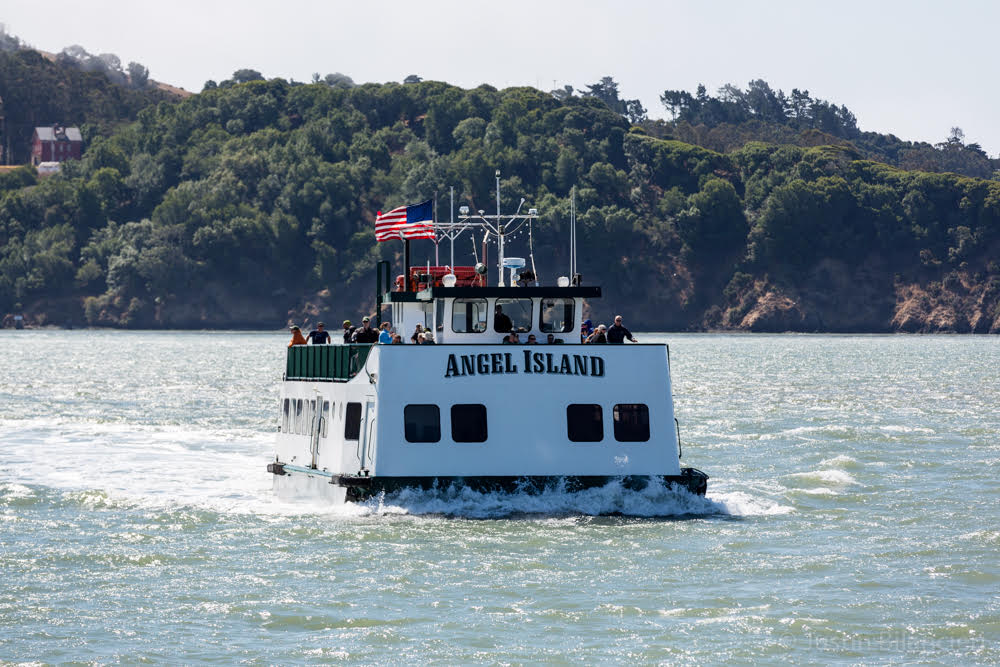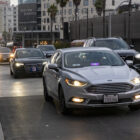A small crowd wearing slate blue suits and nautical whites gathered at the Embarcadero’s Pier 9 Friday morning, New Zealand accents mingling with maritime drawls. The day was bright and clear, and a ferry bobbed in the background.
Christopher Luxon, New Zealand’s prime minister, stepped up to the podium and addressed attendees: “Marine electrification is the new frontier,” he said. “We’re moving the world forward by doing this.”
Luxon, other officials and executives were in San Francisco that morning to sign plans to transition the Angel Island-Tiburon Ferry company’s fleet of three vessels to electric power. That deal put the ferry service on track to be the first in California to fully electrify, as part of a statewide push to satisfy green-energy mandates. The project, which involves a New Zealand company, will create jobs for Latino San Rafael residents who might otherwise struggle to break into similar work.
Sign up for our newsletter for local journalism on environmental issues.
“Latinos don’t have equal access to clean-energy jobs, and any electrification effort we make should be inclusive,” said Graham Balch, chief executive officer of ZeroMar, a San Rafael company that is overseeing the project.
Maggie McDonogh, the fifth-generation owner of the ferry company, echoed the sentiment: “What’s the point of doing something like this without lifting everybody up?”
The freshly penned work agreement tasks New Zealand-based company EV Maritime with constructing a new plug-in hybrid catamaran that can run entirely on electricity for short trips.

Audrey Mey Yi Brown / San Francisco Public Press
Friday morning, local officials and heads of companies, as well as New Zealand’s prime minister, gathered to commemorate the signing of EV Maritime’s contract and the step it represented toward zero-emission maritime transit in California.The company will also replace the hulls of two vessels, formerly powered by diesel engines, to make them lighter so that their new, weaker electric motors can propel them. The redesigns will reduce drag for the boats by raising them 25% out of the water.
“To go all-electric you need maximum efficiency per pound,” Balch said.
EV Maritime aims to convert the two boats by the end of 2025, a company representative told the San Francisco Public Press, which is California’s zero-emissions deadline for ferries that travel fewer than three nautical miles in a single run. The new hybrid catamaran, which does not fall under the mandate, is scheduled to be built by 2027. The company’s ferries shuttle approximately 100,000 passengers each year, and once they shift to electric power they will spare the North Bay 150 tons of greenhouse gasses annually.
Compared with other forms of transit, electrified ferries offer the greatest potential to reduce emissions, said Michael Eaglen, co-founder and chief executive officer of EV Maritime.
“People assume ferries are efficient because they’re public transit, but they’re not. Ferry emissions are many times higher than buses,” Eaglen said. “It’s really important to decarbonize them.”

Courtesy EV Maritime
As part of its contract with Angel Island-Tiburon Ferry, New Zealand-based EV Maritime will build a hybrid catamaran, illustrated above.Zero-emissions vessels spare the earth’s atmosphere not only greenhouse gasses, but also particulate matter, which pollutes the air people breathe, and nitrogen oxide, which contributes to smog, said Steven Cliff, executive officer of the California Air Resources Board, which is funding the electrification project with a $24 million grant.
In addition to buying new charging and grid infrastructure on shore, the grant will fund a program to train and employ Latino San Rafael residents in marine electrification, work in the clean-energy field that is seeing growing demand. The two-year apprenticeship, which ZeroMar will manage with social services organization Canal Alliance, also based in San Rafael, aims to redress imbalanced hiring practices that have kept people of color out of green jobs. Nationally, 16.5% of the clean-energy workforce is Latino, compared with 18% of the workforce across all sectors, according to an analysis by Third Derivative, a climate technology company incubator.
ZeroMar will select two apprentices later this month from graduates of another Canal Alliance workforce development course, which trains immigrants from Guatemala and other Latin American countries with limited resources who are new to the job landscape, said Fabiola Wilcox, who is overseeing the program as Canal Alliance’s workforce target supervisor.
Apprentices will earn $35 per hour to learn on the job from experienced technicians and take supplemental coursework at Santa Rosa Junior College. After completing their training, which will include work on the Angel Island-Tiburon Ferry vessels, they will get marine mechanic positions at ZeroMar with annual salaries of $100,000.
If they were working in other fields, like construction, it would likely be harder for them to earn at that level so early in their careers, Wilcox noted.
The program’s applicants were excited to learn about this opportunity, she said.
“It empowered them because they felt a part of it. It’s big for the community,” Wilcox said.









